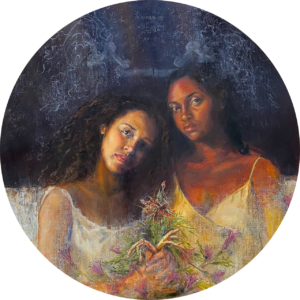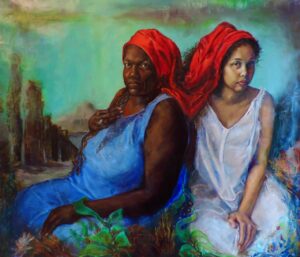If you missed our talk, please watch the video below.
Executive Director of SSCAC, Monique Brinkman-Hill in conversation with artist Kyrin Hobson to discuss her special edition print created in collaboration with our Chicago Printer’s Guild Fundraiser, her multifaceted art practice, and how women and symbolism play a role in her work.
A Los Angeles native, artist Kyrin Hobson enacts her various roles as protector of children, steward of community and keeper of histories through painting, drawing and conceptually engaged social practice focusing on arts education. Hobson’s Chicago studio is a base of operations for art explorations which build upon experiences as a museum professional and scholar of the African Diaspora. Primarily self-taught in painting, the artist has a BA in Fine Art from UCLA and a MA in Museum Studies from NYU. Additional fine art study has included the Women’s Art Institute at the Minneapolis College of Art and Design, and studio intensives with Steven Assael, Stanka Kordic, and Karen Offutt.
Kyrin is a grantee of the Sustainable Arts Foundation, The Minnesota State Arts Board and AS220. She has been in residence at the Millay Art Colony and published in The Edna Journal and Delicious Line. Recent exhibitions include Between Line and Space (South Side Community Art Center), Secondary Meanings: Figural Diptychs (Zhou B Art Center), Reclamation (Helen Day Art Center, Vermont), Visions of Venus/Venus’ Visions (Zhou B Art Center, Chicago), Black Creativity Juried Exhibition (Chicago Museum of Science and Industry). Hobson’s paintings and commissioned portraits feature in collections in the United States, France and Germany, notably including the University of California, Los Angeles, Tina Knowles Lawson and Dr. Elaine Schmidt and Steven Bennett.

According to Hobson:
My drawings and paintings are acts of intercession—the sharp point of a trajectory of memory. I carry forward a family history of clairvoyance used in ritual; in creating, caring for and sustaining life; and in the resourceful exercise of influence. I am the first in my line to deploy this gift as an artist. A strong commitment to interdisciplinary research in history and cultural studies supports my gift of vision.
Hobson adds:
My art gives shape and form to what it has meant to be a Black or mixed-race person in America. The work is body based, emphasizing gaze and gesture of the figure. The physicality of memory also finds form in symbolic depictions of the limbic system, and other bio-imaging. My imagery combines threads of inherited trauma, rage, caregiving and the instinct to survive and even find pleasure in a brutal world. I frequently center a young Black heroine (or hero) in an imagined landscape, often with the tools of her own agency (medicinal plants, folk charms, weapons) and attended by fantastical animals or natural motifs. Beauty is claimed emphatically as both a necessary element of survival and a lever of femme power. At the same time, these works confront the perilous exploitation of the enslaved female body. The drawings and paintings that depict my visions stand as documents of a pragmatic purpose—to reclaim the humanity of marginalized people.




